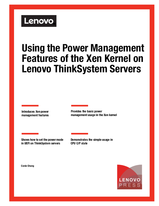Author
Published
19 May 2022Form Number
LP1596PDF size
20 pages, 397 KBAbstract
This paper provides an overview of the power management features of the Xen Kernel as used in SUSE Linux Enterprise Server. provides the basic power management usage, including CPU P-state and CPU C-state.
This paper is intended for IT specialists and IT managers who are familiar with power management and Linux Xen OS.
Table of Contents
Introduction
Basic components
CPU P-States (cpufreq) with Xen
Enabling the use of CPU P-States in Xen
CPU C-States (cpuidle)
Enabling the use of CPU C-States in Xen
Resources
To view the document, click the Download PDF button.
Configure and Buy
Full Change History
Course Detail
Employees Only Content
The content in this document with a is only visible to employees who are logged in. Logon using your Lenovo ITcode and password via Lenovo single-signon (SSO).
The author of the document has determined that this content is classified as Lenovo Internal and should not be normally be made available to people who are not employees or contractors. This includes partners, customers, and competitors. The reasons may vary and you should reach out to the authors of the document for clarification, if needed. Be cautious about sharing this content with others as it may contain sensitive information.
Any visitor to the Lenovo Press web site who is not logged on will not be able to see this employee-only content. This content is excluded from search engine indexes and will not appear in any search results.
For all users, including logged-in employees, this employee-only content does not appear in the PDF version of this document.
This functionality is cookie based. The web site will normally remember your login state between browser sessions, however, if you clear cookies at the end of a session or work in an Incognito/Private browser window, then you will need to log in each time.
If you have any questions about this feature of the Lenovo Press web, please email David Watts at dwatts@lenovo.com.

